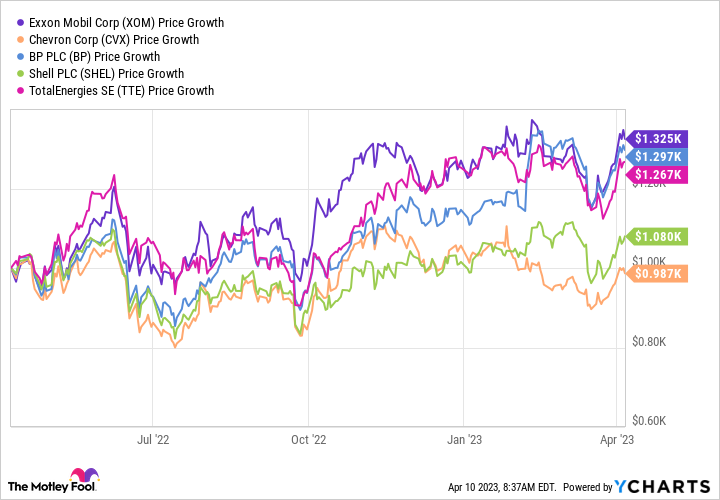U.S. energy giant ExxonMobil’s (XOM 0.24%) stock performance has been better than all of its closest peers over the past year. That’s a great showing, but investors need to step back and look at the bigger picture. While Exxon has been doing well of late, the story isn’t necessarily as good as it sounds.
The past year
Over the past 12 months, a $1,000 investment in Exxon’s stock would have increased to $1,325, looking at stock-only returns. Peers BP, Shell, TotalEnergies, and Chevron (CVX 0.20%) all come in below that figure. U.S. peer Chevron notably pulls up the rear, turning $1,000 into roughly $990. Adding in dividend reinvestment, which is total return, doesn’t materially alter the performance story here though it does push an investment in Chevron back into the black at $1,020.
XOM data by YCharts.
From a big-picture perspective, the question to ask is, why would the performance of Chevron and Exxon be so disparate? They are, basically, the most similar companies in the peer group. Both are U.S.-based, both have chosen to stick fairly closely to their energy industry focus, and both have industry-leading balance sheet strength.
XOM Debt-to-Equity Ratio data by YCharts.
Catching up
If you go back a couple of years, the answer becomes a lot more clear. For example, looking at five-year stock-only returns, Exxon’s lead drops notably. Over that span, it turned a $1,000 investment into roughly $1,540, while a similar investment in Chevron grew to about $1,450. From a total return perspective, adding dividends into the picture, the Exxon investment increased to just shy of $2k, while Chevron turned the original investment into about $1,800.
XOM data by YCharts.
Take that view out one more notch to 10 years, meanwhile, and the roles reverse. A $1,000 investment in Exxon turned into about $1,300 on a stock-only basis and about $2k with dividends reinvested. Chevron turned $1,000 into a little over $1,400, looking just at stock performance, and over $2,100 with dividends reinvested.
XOM data by YCharts.
So what’s going on today, if you look at the impressive near-term performance of Exxon’s shares, appears to be at least partly attributable to the shares catching up rather than true outperformance.
And that makes sense, given that, at the end of the last decade, Exxon was falling behind its peers, notably Chevron, with regard to production growth. It was spending heavily to rectify that situation before the 2020 energy downturn, which was driven by demand declines from economic shutdowns related to the coronavirus pandemic. And now that energy prices have recovered, its business appears to be on a stronger footing than it was prior to the pandemic. Investors have rewarded it for that improvement, which kind of just represented Exxon making up some of the ground it had lost prior to the pandemic, operationally speaking.
A little less exciting
The big takeaway here is that Exxon’s stock has been doing really well of late, but it would probably be a mistake to read too much into that price advance. Following that strong run, the longer term will probably see Exxon and Chevron perform more similarly than dissimilarly. If you own Exxon, you should be pleased, but if you own Chevron, there’s probably no particular reason to jump ship.
